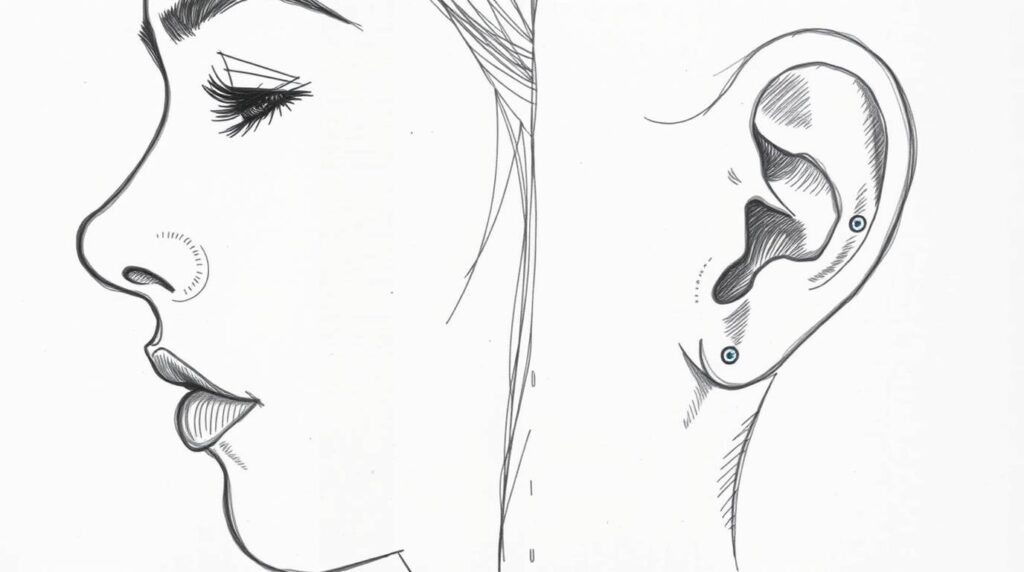1. What Is a Piercing Bump?
A piercing bump (hypertrophic scar) is a common overreaction of your body’s healing process after a piercing. Typically appearing 2–6 weeks post-piercing, it’s soft, pinkish, possibly itchy or slightly oozy—but it doesn’t extend beyond the original piercing area PILGRIM+11Medical News Today+11Estella Collection+11.
Causes:
-
Gentle irritation (friction, jewelry, or accidental knocks)
-
Minor infection or excessive picking
-
Tissue regeneration overshoot
Timeline:
-
Onset: Within weeks
-
Peak: Around 2 months
-
Resolution: Usually 3–6 months with proper care
2. What Is a Keloid?
A keloid is a benign scar characterized by excessive collagen deposition, growing beyond the wound site. It often appears 3–12 months after piercing, with a firm, rubbery texture, and may darken—especially in richer skin tones The Keloid Plastic Surgery CenterThe Keloid Plastic Surgery Center+3Clinikally+3Clove Piercing+3Medical News Today+1Estella Collection+1Riri Piercing+2Wikipedia+2Centre for Minor Surgery+2.
Risk Factors:
-
Genetic predisposition (family history)
-
Darker skin (4.5–16% prevalence) Wikipedia
-
Lingering inflammation or trauma
3. Piercing Bump vs Keloid – Quick Comparison
| Feature | Piercing Bump | Keloid |
|---|---|---|
| Onset | 2–6 weeks | 3–12 months |
| Growth | Localized | Expands beyond piercing |
| Texture | Soft/pliable | Firm/rubbery |
| Colour | Pink/light red | Darker, purplish |
| Progression | Resolves over time | Often persists or grows |
| Treatment | Saline soaks, jewelry change | Steroid injections, silicone, surgery |
| Recurrence Risk | Low | High |
“Piercing bumps appear quickly and do not expand, whereas keloids form gradually and can grow in size” The Keloid Plastic Surgery Center+12Dr Amit Mulay+12Medical News Today+12Public Health Sudbury & Districts+1Dr Amit Mulay+1Verywell Health+12Clinikally+12Estella Collection+12Medical News Today+3The Keloid Plastic Surgery Center+3Healthline+3
4. The Canadian Context
A. Popularity & Demographics
According to Stats Canada, around 27% of teens in Québec had body piercings in 2002—figure may be higher nationwide Medical News Today. Canada’s multicultural population (with Indigenous, Black, South Asian roots) means keloid risk varies significantly.
B. Safety Standards
-
Health Canada mandates licensed piercers to use sterile, single-use tools and clean saline solutions WikipediaClove Piercing.
-
Ontario Public Health prohibits piercing devices on ear cartilage unless strict hygienic measures are followed Southwestern Public Health+5City of Toronto+5Open Alberta+5.
5. Diagnosing in Canada: At-Home vs Professional
Self-Check
-
Soft bump appearing early → likely hypertrophic
-
Firm, growing bump appearing late → possible keloid
When to Seek Help
-
Beyond 3 months with abnormal growth
-
If bump is firm, tender, spreads, or changes color
Start with your local piercer (e.g., Chameleon Studio in Mississauga). If uncertain, see a dermatologist, especially in keloid-prone cases.
6. Treatment Options in Canada
For Piercing Bumps
-
Sterile saline soaks: ½ tsp non-iodized salt in 250 mL boiled water Painful Pleasures+10Verywell Health+10The Keloid Plastic Surgery Center+10Byrdie+2Byrdie+2Estella Collection+2
-
Jewelry: Switch to implant-quality titanium
-
Cleanliness: Twice-daily gentle wash, avoid alcohol/peroxide Clinikally+12SELF+12Centre for Minor Surgery+12
-
Time: Most subside in months with consistent care
For Keloids
-
Corticosteroid injections (every 4–6 weeks): Reduce size significantly Estella Collection+1Byrdie+1
-
Silicone sheets/gel: Worn for 6–12 months
-
Cryotherapy & Laser: May be combined with steroids
-
Surgical excision + adjunct therapy: Referral to dermatologists; ≤70% effectiveness ByrdieWikipedia
7. Prevention & Aftercare for Canadians
Before Piercing
-
Screen for family history of keloids
-
Select reputable piercers with valid certifications
-
Use implant-grade titanium or niobium
Aftercare Essentials
-
Wash hands before touching Verywell Health+2Wikipedia+2Byrdie+2Public Health Sudbury & Districts+2Dr E Dermatology+2Byrdie+2Byrdie+6Triple J’s Collective+6SELF+6
-
Clean twice daily with saline; avoid harsh cleaners appearancecenter.com+13PILGRIM+13Estella Collection+13
-
Don’t rotate jewelry; keep piercing dry and clear
-
Avoid hot tubs, pools, and exposure to contaminants Healthline+11Kids Help Phone+11Triple J’s Collective+11
Extra for Keloid-prone Skin
-
Early use of silicone prophylaxis
-
Add tepid sea‑salt compresses for soothing effect Wikipedia+2City of Toronto+2Riri Piercing+2Wikipedia+4Byrdie+4Estella Collection+4
8. Personal Anecdote & Analogy
As a content strategist in Toronto, I’ve seen many readers panic over early bumps—thinking they’re keloids. But with the right approach, most bumps are just temporary—like a pothole being patched—versus keloids, which are more like persistent speed bumps that need targeted treatment.
9. FAQs
Q1: How long does a piercing bump last?
Typically 3–6 months; soft and fades with care Medical News TodayVerywell Health.
Q2: Are keloids permanent?
They rarely resolve alone; treatment is strongly recommended Byrdie.
Q3: Can I get pierced if prone to keloids?
Yes, but avoid cartilage, keep jewelry in, and use silicone early.
Q4: Do steroids work for keloids?
Yes—often shrink lesions significantly Byrdie.
Q5: Can silicone sheets prevent keloids?
When used early and consistently, they can reduce formation.
Q6: When to see a dermatologist?
If bump is firm, growing, or persistent after 3 months.
10. Canadian Costs & Resources
Price Estimates (Ontario)
-
Sterile saline kit: 15–25 CAD
-
Implant-grade jewelry: 20–50 CAD
-
Corticosteroid injection: ~$150 CAD/session
-
Silicone sheets: 30–60 CAD
-
Laser sessions: $300–600 CAD
Trusted Local Clinics
-
Chameleon Studio – Piercing Services (Mississauga): 248 Queen St S, ON L5M 1L8
-
💬 Questions? Visit our Contact Page or call +1 647‑328‑8992
11. Bonus: Canadian Perspective & Authority
Chameleon Studio, located at 248 Queen St S, Mississauga, follows all provincial sanitary regulations and offers post-care guidance and referrals to local dermatologists if needed.
Internal links included:
Conclusion & CTA
Understanding the difference between a piercing bump and a keloid ensures you take the right actions without unnecessary worry. With Canada’s regulatory safeguards, high-quality studios, and dermatology resources, you’re well supported.
Got questions about piercing bumps or keloids in Canada?
📞 Call us at +1 647‑328‑8992 or leave a comment below—we’re here to help you heal confidently!

